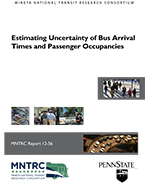Abstract:
Travel time reliability and the availability of seating and boarding space are important indicators of bus service quality and strongly influence users’ satisfaction and attitudes towards bus transit systems. With Automated Vehicle Location (AVL) and Automated Passenger Counter (APC) units becoming common on buses, some agencies have begun to provide real-time bus location and passenger occupancy information as a means to improve perceived transit reliability. Travel time prediction models have also been established based on AVL and APC data. However, existing travel time prediction models fail to provide an indication of the uncertainty associated with these estimates. This can cause a false sense of precision, which can lead to experiences associated with unreliable service. Furthermore, no existing models are available to predict individual bus occupancies at downstream stops to help travelers understand if there will be space available to board.
The purpose of this project was to develop modeling frameworks to predict travel times (and associated uncertainties) as well as individual bus passenger occupancies. For travel times, accelerated failure-time survival models were used to predict the entire distribution of travel times expected. The survival models were found to be just as accurate as models developed using traditional linear regression techniques. However, the survival models were found to have smaller variances associated with predictions. For passenger occupancies, linear and count regression models were compared. The linear regression models were found to outperform count regression models, perhaps due to the additive nature of the passenger boarding process. Various modeling frameworks were tested and the best frameworks were identified for predictions at near stops (within five stops downstream) and far stops (further than eight stops). Overall, these results can be integrated into existing real-time transit information systems to improve the quality of information provided to passengers.
Authors:
VIKASH V. GAYAH, PH.D.
Vikash V. Gayah, PhD, is an assistant professor in the Department of Civil and Environmental Engineering at the Pennsylvania State University and served as the principal investigator for this project. He received his BS and MS degrees from the University of Central Florida (2005 and 2006, respectively), and his PhD degree from the University of California, Berkeley (2012). His research interests include urban transportation operations and network modeling, transit system operations, traffic safety, and statistical and econometric modeling of transportation data. He has over 10 years of research, teaching, and industry experience. Dr. Gayah currently serves as a member of the Traffic Flow Theory and Characteristics committee (AHB 45) of the Transportation Research Board and is an editorial advisory board member of Transportation Research Part B. His recent recognitions include Outstanding Student of the Year for the University of California Transportation Center (2011-2012), a Dwight D. Eisenhower Graduate Fellowship (2011-2012) and the New Faculty Award presented by Cambridge Systematics and the Council of University of Transportation Centers (2015-2016).
ZHENGYAO YU
Zhengyao Yu is a PhD candidate in his first year of study in the Department of Civil and Environmental Engineering at Penn State. He received his BS degree (2014) from Tongji University (Shanghai, China) and his MS degree (2015) from Penn State, both in civil engineering. His research interests include traffic network modeling, traffic flow theory, and transit system operations. He is a recipient of an American Public Transportation Foundation Scholarship (2015) and a College of Engineering Recruitment Fund Graduate Fellowship at Penn State (2014).
JONATHAN S. WOOD
Jonathan S. Wood is a PhD candidate in his final year of study in the Department of Civil and Environmental Engineering at Penn State. He received his BS (2011) and MS (2012) degrees in civil and environmental engineering from the University of Utah. His research interests include advanced statistical and econometric analysis of transportation data, traffic safety, geometric design, and public transit systems. He currently serves as a young member of the Geometric Design Committee (AFB 10) of the Transportation Research Board. Mr. Wood is a recipient of a College of Engineering Distinguished Teaching Fellowship at Penn State (2015-2016), a Dwight D. Eisenhower Graduate Fellowship (2014-2015), and was the Outstanding Student of the Year for the Mountain Plains Consortium (2013) and the Mid-Atlantic Universities Transportation Center (2016).


